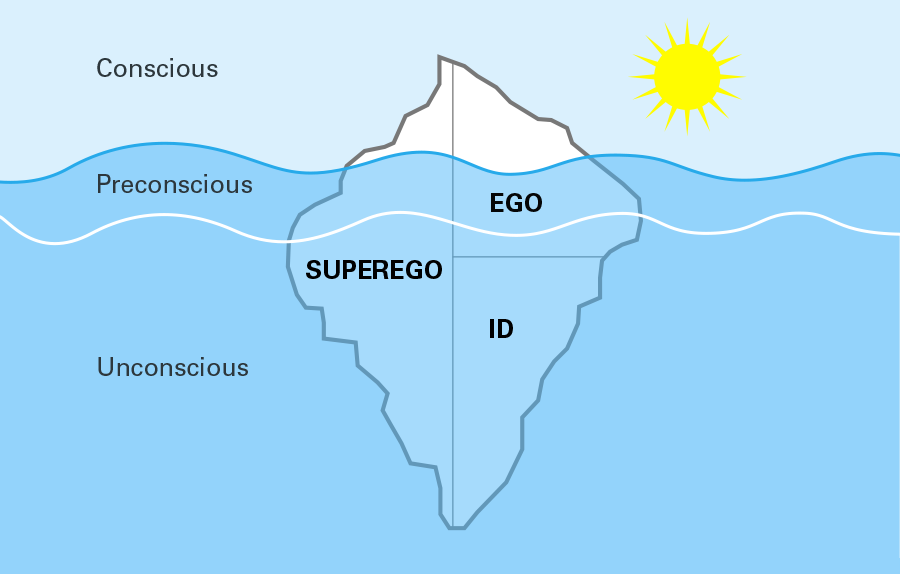PSYCHOANALYSIS
4.3
Psychoanalytic Methods
What were some of the main concepts and methods introduced by Freud to his Clark University audience?
Check your notes on your reading of Freud’s “The origin and development of psychoanalysis” (1910). Did you pick up on some of the concepts and methods listed below?
| Concept / Method | Description |
|---|---|
| Libido | Freud thought of libido as a sexual energy or force, analogous to hunger, a basic instinct innate in all humans, that passed through a series of developmental stages. Failure to adapt to the challenges presented in the different stages could result in libidinal energy becoming fixated in these stages, producing pathologies later in childhood or adulthood. |
| Oedipus complex | Child’s unconscious sexual desire for a parent and hatred for the other parent. Freud thought that a child’s identification with a parent is a successful outcome of the complex and that an unsuccessful resolution of the complex could lead to pathology and sexual deviance. |
| Repression | A defense mechanism, involving placing an unpleasant or anxiety-provoking thought or memory in the unconscious. |
| Sublimation | A type of defense mechanism by which socially unacceptable behaviors are replaced with socially acceptable ones, resulting in a positive channeling of the initial impulse, such as in the creation of art or innovation. |
| Regression | Defense mechanism involving reverting back to immature behavior from an earlier stage of development. |
| Hypnosis | Technique to probe the unconscious and cure it (through hypnotic suggestion that would release repressed energy); Freud abandoned hypnosis early on in favor of other techniques, such as interpretation of dreams. |
| Dream analysis | Freud thought of dreams and their interpretation as “the royal road” to the unconscious (like hypnosis, dreams represent an altered state of consciousness), dreams deal with wish fulfillment, unconscious desires and conflicts; dreams contain both manifest and latent content, with the latter representing repressed, symbolic meaning. The therapist aims to uncover the meaning of the latent content and uses additional techniques (e.g., free association) to further probe the mental conflict. |
| Free association | Freud would ask patients to share thoughts, words, or images that came freely to mind or in reaction to some cue; he then interpreted the results to uncover unconscious thoughts and sources of conflict. |
| “Freudian” slips | Freud interprets the meaning of everyday bungling of acts, such as slips of the tongue (saying “bed and butter” instead of “bread and butter” in the presence of an attractive individual) and uses these as an investigative technique to reveal unconscious desires or sources of mental conflict. |
Did you miss something?
Psychology textbooks and other introductions to psychoanalysis often begin their treatment of Freud’s theory by describing his famous id-ego-superego trichotomy. However, this distinction was a late development in Freud’s thinking that only emerged in the 1920s. As you gathered from reading his introduction to psychoanalysis, by 1910 Freud’s main ideas about the importance of unconscious drives and psychological conflict, as well as his views on child sexuality and development, were well developed and did not depend on this terminology. As Fancher (1998) suggests, the tripartite distinction id-ego-superego is a late attempt to deal with some terminological problems raised by previous loose uses of such terms as “unconscious” and “preconscious”:
“In 1923, concern over some technicalities in psychoanalytic terminology stimulated Freud to write The Ego and the Id. Previously he had used the terms “unconscious” and “preconscious” both as adjectives (e.g., to describe an “unconscious wish” or a “preconscious memory”) and as nouns (postulating “the Unconscious” or “the Preconscious” as separate systems in the psyche). But Freud was troubled by the fact that several of the important processes he had attributed to the preconscious system actually occurred unconsciously, and that certain repressed components of the Unconscious system were structured like preconscious material. Thus he now renamed “the Unconscious” as the id, and “the Preconscious” as the ego. Further, he had become increasingly aware of situations when conflicts between the instinctual drives and external reality are further complicated by moral demands. For example, sometimes one abstains from seeking a desired object, or feels guilty at the very thought of doing so, simply out of a feeling that it would be wrong. Freud reasoned that the source of this moral force in the psyche was acquired rather than innate, since very young children and some psychopathic adults lack it. It also seemed to be based on some kind of unconscious identification with authority figures from the developing child’s society, and to have a certain amount of independent energy at its disposal to create feelings of guilt. Accordingly, Freud postulated the superego as a separate entity in his new conception of the psyche, the result of a childhood identification with the same-sexed parent in the Oedipal relationship.”

The popular iceberg metaphor is often used to explain Freud’s tripartite view of the psyche, which included id, ego, and superego. Freud’s structural id-ego- superego distinction was a late addition to Freud’s theory, which goes to show that psychoanalysis was a theory in constant development.
(Public domain)
References
Fancher, R. E. (1998). Commentary on “The Origin and Development of Psychoanalysis” (pp. 31-38). Classics in the History of Psychoanalysis, 1-5. http://psychclassics.yorku.ca/Freud/Origin/commentary.htm
Please note that certain links to journal articles are only available within the eduroam network if they concern publications for which the university has a campus license. If you are a member of the University of Basel and want to access university resources from home, you will need to install a VPN client.
Lizenz
University of Basel
